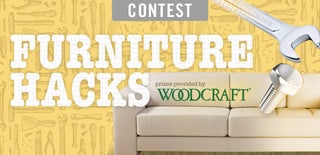Introduction: How to Restore Antique Furniture
Don't throw away antique furniture. You might see crap covered in dust and spiderwebs, but all I see is potential. It is said that old people often times still feel young on the inside, and the same goes for this old table. It stood rotting away in a children's playhouse for years, before I found it and took care of it. This table is called Draw Leaf Table. This means that it's built up from three loose segments, of which the ones on the outside can be folded up of down, for extra surface area. The wooden mechanism supporting it along with the copper hinges (which were beyond repair) indicate the table is really old. Let's bring it to its full potential!
Step 1: Choosing the Right Tools
As any project, it starts with selecting the right tools. A cabinet scraper, like the Stanley No. 80, is extremely great for cleaning up wood. I had to restore mine before I could use it. After removing the paint and rust, I flattened the sole and sharpened it up. The waterstones and a screwdriver came in really handy for this.
The cabinet scraper takes a really thin shaving, and it can't be used to take off lots of material. Next to that, it is harder to keep a flat or straight surface using it. Therefore, I added a jointer plane and a coffin smoother to my tool kit. You'll see why in just a minute.
For the hard to reach spots on the frame, I used a card scraper and a power sander.
Now that's out of the way, let's get started!
Step 2: Cleaning the Table Top
After disassembling everything, I started taking care of the table top. Putting the pieces between the bench dogs, I started by taking a quite heavy shaving with the Stanley No. 80. I quickly revealed the aged oak, and I was just amazed by the beauty of it. The cabinet scraper worked really well for the end grain as well. I clamped the pieces in my large wooden vise and used a light shaving to reveal the end grain.
The middle piece had warped a little through being exposed to the elements. There were some punky and low spots as well. Using the jointer and the coffin smoother, I flattened the top and gave it a nice, even surface.
The jointer plane also came in handy to straigthen the 'straight' sides of the table. I put the pieces in my vise again and put a square edge, straight edge on all of the sides, constantly checking for square. The trick here is to make sure your jointer plane is well adjusted laterally, which takes a little time. I take a thin shim of wood and put it in my vise, and adjust it untill I get a shaving that is the same thickness on either side of the cutting edge. Hope that makes sense.
I sanded the tabletop lightly with 400 grit sandpaper and Scotch Brite. This gave the oak a really neat shine!
After scraping, the wood is completely finish-ready so sanding is completely optional.
Step 3: Cleaning the Frame
The frame was glued together really well, so taking it apart was impossible. This meant I had to use a bit of ingenuity. The cabinet scraper cleaned up most of the wood but left it dirty near the legs. I used a utility knife as a scraper, and scraped it clean. To save some time, I sanded the hard to reach spots with 180 grit sandpaper. With the frame cleaned up nicely, everything was ready for some finish.
Step 4: Finish(ed)!
After I cleaned everything up, the table was ready for some finish. I rubbed everything down with two coats of linseed oil, and let it dry for a while. To really make the table top shine, I added three coats of beeswax finish. I scoop some hard wax from its can and use a sponge to rub it in. I start with high-pressure, circular motions, which turn into figures of eight along the whole length of the table. The figures of eight change in straight lines, with just a little pressure behind it. Buff it out slowly untill you have a nice, even shine. And that's your new table!
Step 5: Check Out the Video Tutorial!

Runner Up in the
Furniture Hacks Contest











